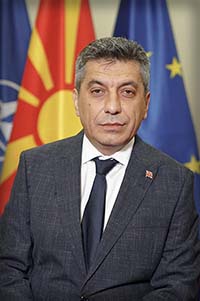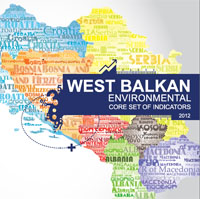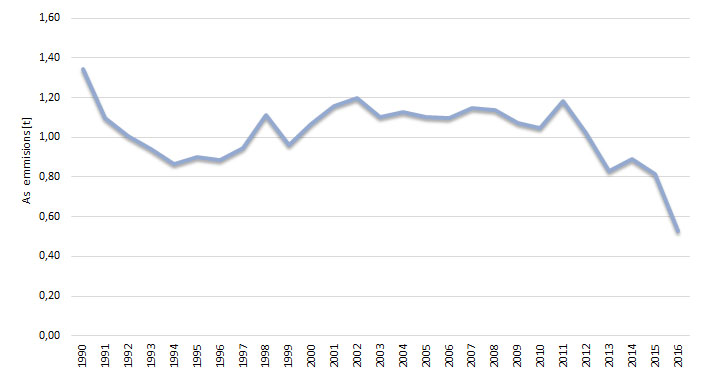| EMMISSION OF HEAVY METALS – ARSENIC (As) |
The indicator tracks the trends inarsenic (As).
t (tons per year)
What progress has been made in overall reduction of emissions of arsenic in the Republic of Macedonia?
In 1990, the overall national emissions of As amounted to 1.34 t, followed by reduction in emissions up to 1996 and then they are increasing with a constant trend by 2012. In 2013 there is a reduction of arsenic emissions with a constant trend till 2015, and then in 2016 there is a significant reduction in emissions by 61% compared to 1990 and 35% compared to 2015. The most important reduction in As emissions is in sector 2 – Industrial processes and the use of other products (metal production). The most significant reductions in As emissions in 2016 occurred in NFR category 2 – Industrial processes (production of metals)due to the reduced production of ferroalloys.
The Diagram below shows annual trend in arsenic (As) emissions for the period 1990to2016.
Diagram 1.Trend in emissions of arsenic (As)
Under the CARDS Programme, Inventory of air emissions of the main pollutants in the country was established in 2005 in accordance with the EMEP methodology by individual sectors, i.e. activities, and in 2014 Inventory including all pollutants was prepared.
Sectors based on the above mentioned methodology and SNAP – selective nomenclature of air pollution are presented in the table below:
| Sector |
| Energy Production and distribution |
| Commercial, instiucional and households |
| Industry (combustion) |
| Industry (production) |
| Fugitive emissions |
| Use of solvents and products |
| Road transport |
| Non-Road transport |
| Waste |
| Agriculture |
| Other |
The most important source of As emissions in 2016 is the sector Energy production and distribution with share of 90%. The other sectors have a significantly lower share in total arsenic emissions.
Diagram 2. Emissions ofArsenic (As) bysectors in 2016
Which different sectors and processes contribute to emissions of Arsenic (As)?
The main sources of As emissions in the period 1990-2016 were the NFR category 1A1 Energy industries (where reduced emission of As has been observed during the last years), as well as NFR category 2 Industrial processes. In 2016 there is a significant reduction in arsenic emissions from NFR category 2 – Industrial processes, with this category accounting for only 1% in total emissions and compared to 1990 is down by 99% and compared to 2015 by 98%. In 2016 even 90% of the total arsenic emissions are from the NFR category 1A1 Energy production, although in this NFR category in 2016 there is a decrease in arsenic emissions by 44% compared to 1990, and by 17% compared to 2015.
Diagram 3. Emissions of Arsenic (As) by NFR categories per year
 Data coverage: excel_1, excel_2
Data coverage: excel_1, excel_2
Sources of data: The data used refers to overall national emissions and emissions categorized by NFR delivered by EEA member and collaborating states to EEA and Secretariat of the United Nations. Data is accessible per country on the following web address:http://cdr.eionet.europa.eu/mk/un/clrtap/inventories/envwovm7g/.
- Methodology for indicator calculation
The methodology for this indicator calculation is based on calculated national emissions and emissions by NFR categories of this pollutant as reported to EEA (European Environmental Agency) and UNECE/EMEP (United Nations Economic Commission for Europe/Cooperative programme for monitoring and evaluation for transboundary air pollution transfer under the Convention on Transboundary Air Pollution Transfer) in February 2016. Data used in this report is in accordance with the data submitted, the difference being that additional allocation of national emissions has been made apart from NFR (as sent to international organizations) also by sectors.
Methodology used for calculation and presentation of this indicator is given in EMEP/EEA Guidebook for inventory of air pollutant emissions of 2009, Guidebook of 2013 and Guidebook of 2016 which may be accessed at the following links http://www.eea.europa.eu/publications/emep-eea-emission-inventory-guidebook-2009, http://www.eea.europa.eu/publications/emep-eea-emission-inventory-guidebook-2013and http://www.eea.europa.eu/publications/emep-eea-guidebook-2016).
Action Plan for European Partnership, as well as National Plan for approximation of the national legislation with European regulations specifying bylaws that need to be prepared have been adopted.
The National Environmental Action Plan (NEAP II) was adopted. It contains the measures that need to be taken to improve the overall status of air quality, including the reduction of emissions of acidifying substances. The National Plan for Ambient Air Protection for the period 2012 to 2017 specifying the measures for air protection on national level and the National Programme for gradual air emissions reduction by 2020 have been adopted in order to define and implement measures on national level.
At the same time, for the purpose of air quality improvement in certain local self-government units (LSGUs) with action plans, program was prepared for the City of Bitola. Air quality plans and short term action plans for city of Skopje and city of Tetovo are prepared in the Twining project “Further strengthening the capacities for effective implementation of the acquis in the field of air quality”, which were adopted by the councils of the municipalities.Addtionally the municipality of Veles also has prepared and adopted air quality plan in November 2017.
Does any of the national documents set target or target should be achieved in accordance with other international documents?
National strategic documents listed as references in the above text provide guidelines and specify actions that should be undertaken as a matter of priority. It is important to mention thatbylaws have been prepared in the area of air emissions transposing Directives 96/61/EC, 2000/81/EC, 2000/76/EC, 99/13/EC and 2001/81/EC, ranging between 90 and 100%.
In accordance with the requirements of the UNECE Convention on Long-Range Transboundary Air Pollution, inventory based on EMEP/EEA Guidebook for inventory of polluting substances into the air, setting the target of regular inventory of pollutants in tons per year following the n-2 principle, where n is the current year.
Legal basis
The Law on Ambient Air Quality adopted in August 2004 and amended several times afterwards (Official Gazette of RM no. 67/2004, 92/2007, 83/2009, 35/10, 47/11, 100/12, 163/2013,10/2015 и 146/2015) is framework law in the area of air. The goals of this Law include avoiding, prevention and reduction of harmful effects on human health and environment as a whole, prevention and abatement of pollutions Arsenicing to climate change, as well as provision of appropriate information on the quality of ambient air.
On the basis of the Law on Ambient Air Quality, 16 bylaws were prepared and adopted to introduce limit values for air quality and air emissions, methodology of air quality and air emissions monitoring, manner of preparation of planning documents for air protection against pollution, manner of informing the citizens and international organizations, etc.
In relation to this polluting substance, the limit values and thresholds for assessment in accordance with the Framework Air Directive 2004/107/EC are prescribed in the following bylaws: Decree on the limit values for the levels and types of polluting substances in the ambient air and alert thresholds, deadlines for limit values achievement, margines of tolerance for the limit value, target value ands and long-term objectives and Rulebook on criteria, methods and procedures for ambient air quality assessment.
- Reporting obligations towards international agreements – UNECE-CLRTAP and ЕЕА
- Annual Report of Processed Data on Air Emissions
| Code | Title of the indicator | Compliance with CSI ЕЕА or other indicators | Classification by DPSIR | Type | Linkage with area | Frequency of publication | |
| MK NI 063 | Emissions of heavy metals – Arsenic (As) | P | A |
|
annually | ||







































































